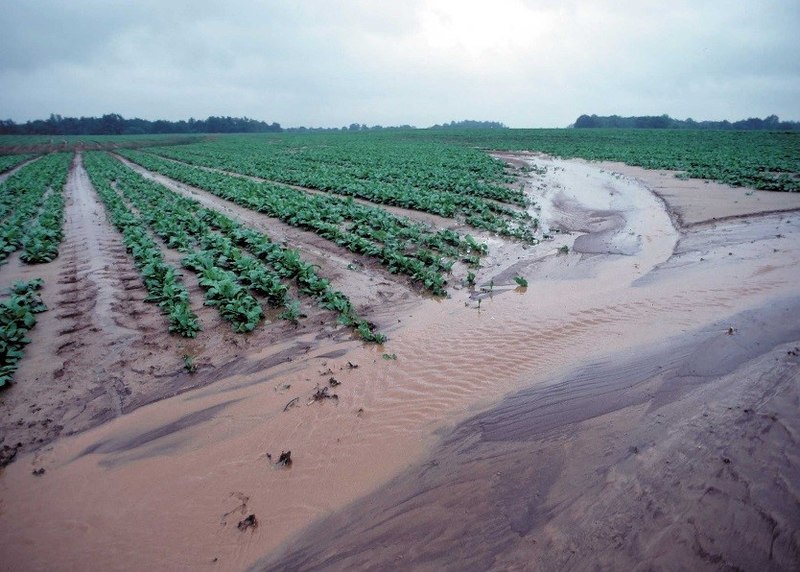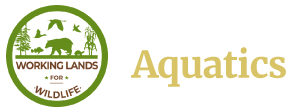Fighting Sedimentation with the ACF
Aquatic Connectivity Framework Reduces Sedimentation and Protects Aquatic Ecosystems
by: Brian Rhodes
Rivers and streams are the lifeblood of our environment, home to a stunning array of wildlife, from fish and amphibians to the aquatic insects that form the foundation of the food chain. However, these ecosystems are under growing threat from sedimentation and siltation. When excess soil and fine particles wash into waterways, they cloud the water, smother habitats, and disrupt the delicate balance that sustains aquatic life. The consequences ripple throughout the food chain, from the tiniest insects to the largest fish, threatening sensitive species like the Eastern hellbender and endangering fisheries.

What’s Causing the Problem?
Some sedimentation occurs naturally, which can be ecologically productive. However, too much sediment can have detrimental impacts. Human activities are accelerating this process and endangering aquatic ecosystems around the world. Sediment is considered a major pollutant to our streams and rivers.
Several causes are driving excess sediment into our waterways:
- Erosion from Agricultural Practices: Without effective farm management practices, crop fields and pastures can become a significant source of soil erosion. Rainfall can carry topsoil from fields into streams, while livestock trampling streambanks damages vegetation and accelerates erosion.
- Development: Construction sites and land clearing for urban expansion remove vegetation and expose soil. Rain easily washes the soil into nearby waterways without natural plant cover to hold it in place, increasing sediment loads.
- Forestry Practices: Removing trees without careful planning can leave soil vulnerable to erosion, particularly on slopes near water bodies. Once the soil starts moving downhill, it often ends up in rivers and streams.
Why We Must Act Now to Stop Siltation
The sediment that flows into waterways from these activities settles on streambeds, smothering the gravel and rocks that many aquatic species rely on for habitat. This harms macroinvertebrates, such as mayflies, stoneflies, and caddisflies, which are essential to the aquatic food web. These tiny insects are a primary food source for fish and amphibians, and their decline can trigger a trophic cascade—a disruption that affects the entire food chain, from macroinvertebrates to larger fish like trout and bass.
How the Aquatic Connectivity Framework Is Making a Difference
The WLFW Aquatic Connectivity Framework is tackling these challenges head-on through NRCS programs. Through this initiative, landowners receive the technical support, cost-share assistance, and guidance needed to implement conservation practices (CPs) that reduce sedimentation, improve water quality, and restore the health of our waterways. These practices protect not just water but the entire ecosystem, from the tiniest insects to the largest fish.
Conservation Practices Include:
- Riparian Forest Buffer (CP391): Planting trees and shrubs along streambanks stabilizes soil and reduces erosion. This vegetation provides shade that keeps water cool for aquatic life and creates a habitat for macroinvertebrates, which thrive in the complex root structures.
- No-Till Practices (CP329): Keeping crop residues on the soil surface protects against erosion by reducing soil disturbance and preventing sediment from entering streams.
- Critical Area Planting (CP342): Vegetation in erosion-prone areas is crucial for preventing soil loss during heavy rains and protecting the habitat for fish and aquatic insects that rely on clean streambeds.
- Conservation Cover (CP327): Establishing permanent vegetation helps reduce runoff, stabilizes the soil, and keeps it from washing into waterways.
- Riparian Herbaceous Cover (CP390): Grasses and herbaceous plants along waterways filter sediments before they can reach the water.
- Access Control (CP472): Limiting livestock access to streambanks prevents damage to vegetation and streambanks and reduces the risk of sediment entering the water.
- Stream Crossing (CP578): Stable crossing points for livestock and vehicles prevent disturbances to streambeds, reducing sedimentation.
- Stream Habitat Improvement and Management (CP395): This practice enhances in-stream habitats, ensuring stable conditions for fish, aquatic insects, and other species.
A Brighter Future for Our Aquatic Ecosystems
Through the technical support provided by NRCS and partners, landowners are empowered to implement these conservation practices and make a lasting impact on the health of our rivers and streams. The Aquatic Connectivity Framework is helping to reduce sedimentation, protect fisheries, and ensure cleaner water, not just for people but for the countless species that depend on these ecosystems, from the tiny macroinvertebrates at the bottom of the food chain to the threatened hellbender salamander. It provides a win-win approach with strategies to improve working lands and strengthen wildlife management.
Together, we’re paving the way for a future where our aquatic ecosystems are resilient, and conservation practices improve the value of the land for producers and wildlife.























